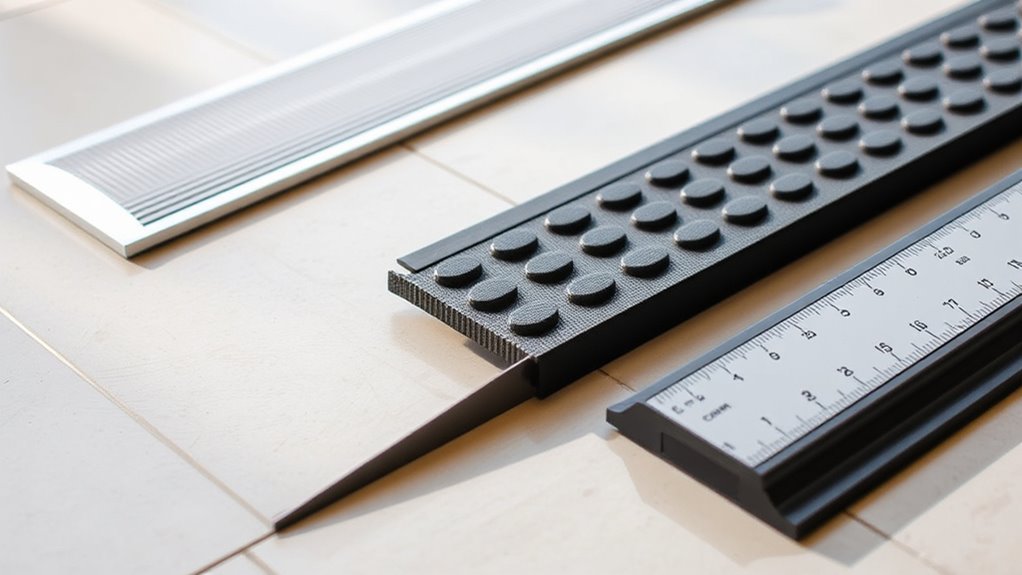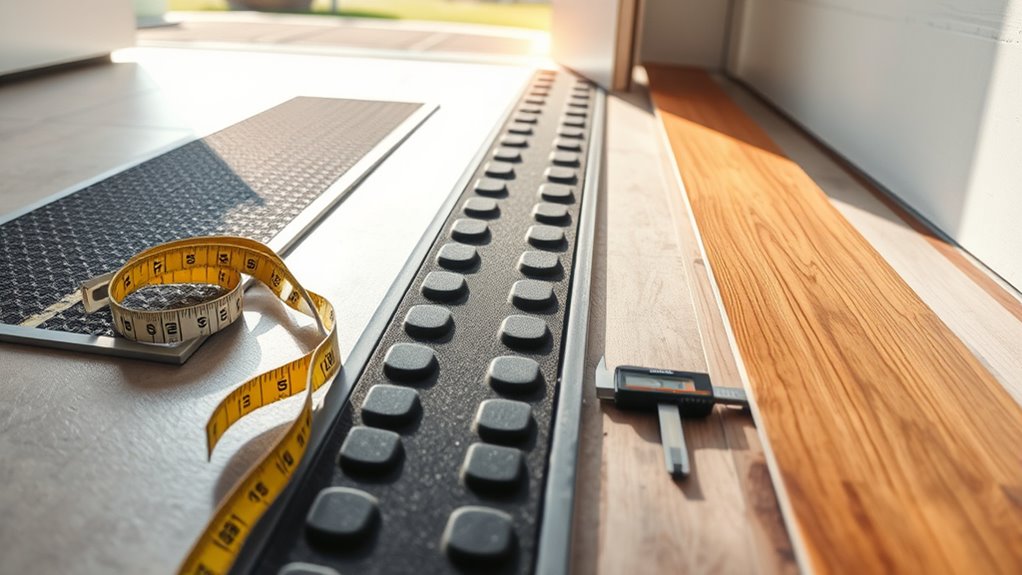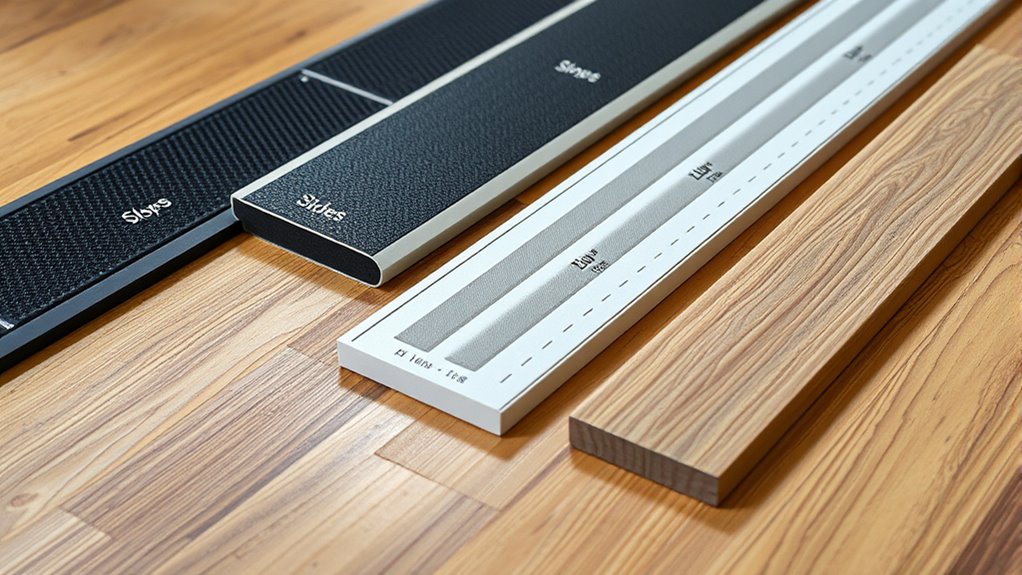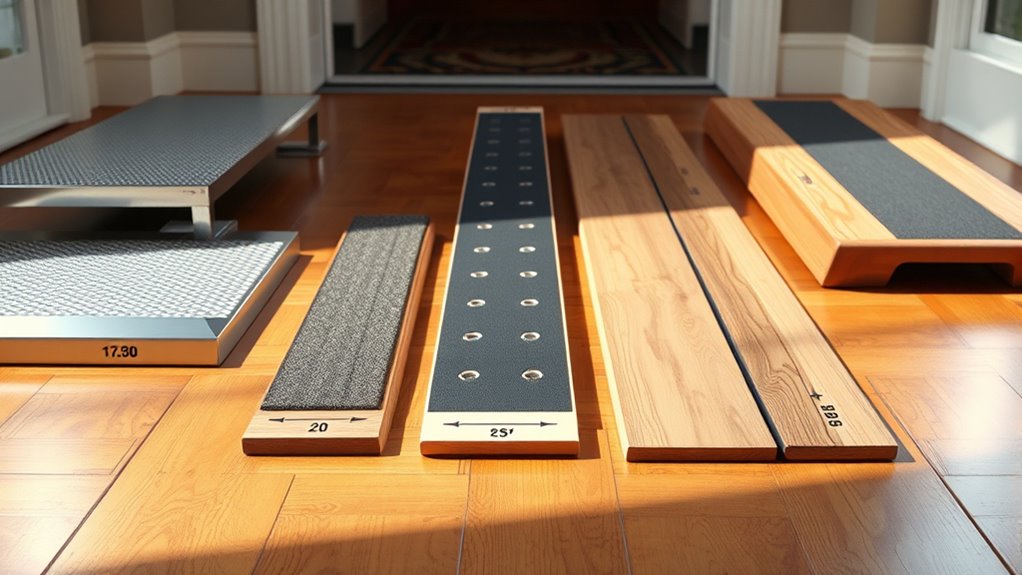Threshold ramps come in various types like foldable, fixed, and portable, each suited for different needs. To find the right one, measure your doorway’s width, height, and depth accurately using a tape measure. Key features to ensure include non-slip surfaces, durable materials, and weight capacity. Proper selection ensures safety and compliance, whether for permanent or temporary use. Keep exploring to learn how to choose and measure the perfect threshold ramp for your needs.
Key Takeaways
- Different types include foldable, fixed, and portable ramps, each suited for specific environments and needs.
- Proper measurement of doorway width, height, and irregularities ensures a secure and functional ramp fit.
- ADA compliance and safety standards are essential considerations when selecting and installing threshold ramps.
- Features like non-slip surfaces, high-quality materials, and gentle slopes improve safety and durability.
- Environment and user requirements influence the choice of ramp type, surface texture, and installation method.
Exploring Different Types of Threshold Ramps

Have you ever wondered which threshold ramp best suits your needs? Choosing the right type depends on several factors, including ADA compliance and ease of ramp installation. There are various options, such as foldable, fixed, and portable ramps, each designed for different settings. Fixed ramps are sturdy and ideal for permanent installations, guaranteeing ADA compliance for long-term accessibility. Portable ramps offer flexibility, making them perfect for temporary or multi-use situations. Foldable ramps combine convenience with stability, allowing easy transport and setup. When selecting a threshold ramp, consider your specific environment and user needs to guarantee safety and compliance. Proper installation is vital to maximize safety and meet ADA regulations, so choose a design that fits seamlessly into your space. Additionally, understanding ramp safety standards can help ensure your choice maintains accessibility and safety for all users.
How to Measure for the Perfect Fit

Determining the correct measurements is essential to make certain your threshold ramp fits securely and functions safely. Start with visual measurement techniques by carefully inspecting the doorway and noting the width, height, and depth of the area. Use a tape measure to capture precise dimensions, ensuring you account for any irregularities or obstructions. Consider ergonomic design considerations, like the slope angle and surface texture, to optimize safety and comfort. Measure both sides of the threshold for asymmetries, and record these dimensions accurately. Don’t forget to include extra space for any additional features like handrails or edge borders. Accurate measurements help you select or customize a ramp that seamlessly integrates with your space, providing stability and ease of use for all users. Additionally, understanding the contrast ratio of your environment can influence the choice of ramp surface to improve visibility and safety.
Key Features and Considerations for Selection

When selecting a threshold ramp, focusing on key features guarantees safety, durability, and ease of use. Start with installation tips—choose a ramp with a non-slip surface and secure fitting options to prevent movement. Material durability is essential; opt for high-quality materials like aluminum or heavy-duty plastic that withstand weather and daily wear. Consider the ramp’s weight capacity to guarantee it supports your needs safely. Ease of installation is important, so look for ramps that are straightforward to set up without specialized tools. Also, check for smooth edges and a gentle incline to minimize tripping hazards. Additionally, understanding organic and natural juice options can inspire designing accessible ramps that accommodate various needs. By prioritizing these features, you’ll select a ramp that remains reliable, simple to install, and long-lasting, providing safe access for years to come.
Frequently Asked Questions
Are Threshold Ramps Suitable for Outdoor Use in All Weather Conditions?
Yes, threshold ramps are suitable for outdoor use in all weather conditions if they have weather resistance and durable materials. You should look for ramps made from materials like aluminum, steel, or heavy-duty plastic, which withstand rain, snow, and sun. Properly maintained, these ramps can last for years, ensuring safety and accessibility regardless of weather. Always check the product specifications for weather resistance before installation.
How Long Do Threshold Ramps Typically Last With Regular Use?
You might think threshold ramps last forever, but reality checks in with durability testing revealing otherwise. With regular use, expect them to endure roughly 3-5 years, depending on material longevity and environmental exposure. Heavy foot traffic or harsh weather can cut that time short, so you’ll want to keep an eye on their condition. Proper maintenance can stretch their lifespan, but don’t expect them to be invincible—like all things, they wear down over time.
Can Threshold Ramps Be Easily Installed by Homeowners Without Professional Help?
Yes, you can usually handle DIY installation of threshold ramps if you have basic tools like a drill, screwdriver, and level. Most ramps come with clear instructions, making it easier for you to measure, position, and secure them properly. Just guarantee you follow the guidelines closely, and take your time to get a secure fit. If you’re unsure, consulting a professional can help ensure safety and proper installation.
What Safety Features Should I Look for in a Threshold Ramp?
You absolutely need safety features like non-slip surfaces that grip like a mountain climber and sturdy handrails that can hold a small fortress! These guarantee you don’t slip or fall, even in the rain or snow. Look for ramps with textured surfaces to prevent accidents and strong, reliable handrails for support. Prioritize these features to make your threshold ramp as safe as a fortress guarding your home.
Are There Weight Limits I Should Consider for Different Ramp Types?
Yes, you should consider weight limits for different ramp types. Check the weight capacity to guarantee it can support your needs safely. Durable materials like aluminum or heavy-duty plastic typically offer higher weight capacities, making them suitable for heavier users. Always verify the manufacturer’s specifications for weight limits and material durability, so you select a ramp that provides safety, stability, and long-lasting performance for your specific requirements.
Conclusion
Now that you know the ins and outs of threshold ramps, you’re better equipped to make the right choice. Remember, the right ramp can be a game-changer, turning obstacles into mere bumps in the road. Don’t settle for less—ensure your selection fits perfectly and meets your needs. When you prioritize safety and accessibility, you’re paving the way for a smoother journey ahead. It’s all about making life easier, so don’t let opportunities slip through your fingers.









